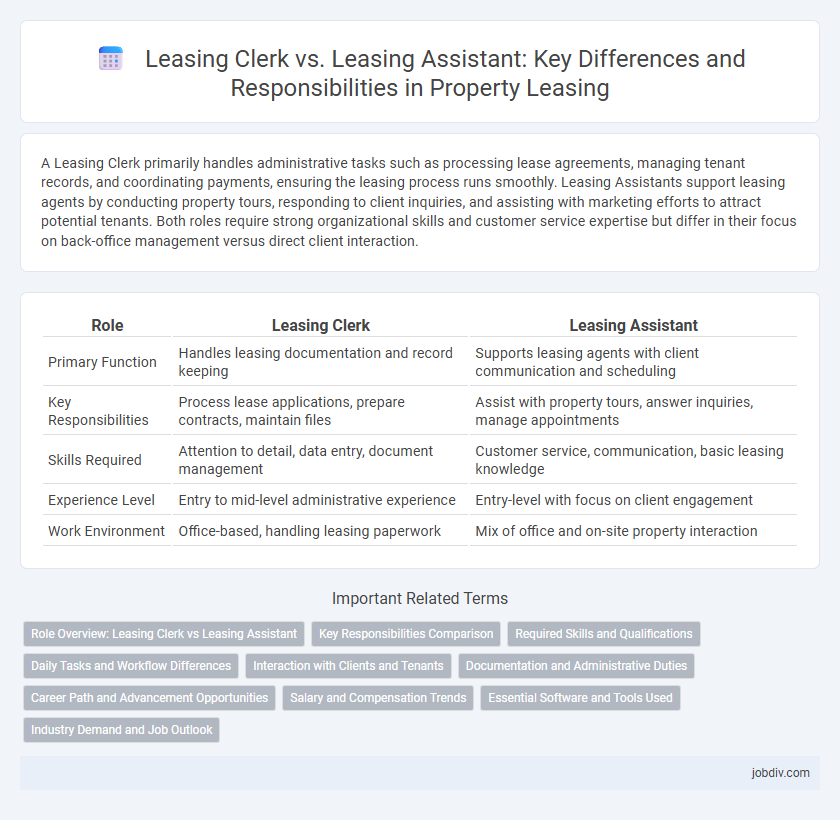A Leasing Clerk primarily handles administrative tasks such as processing lease agreements, managing tenant records, and coordinating payments, ensuring the leasing process runs smoothly. Leasing Assistants support leasing agents by conducting property tours, responding to client inquiries, and assisting with marketing efforts to attract potential tenants. Both roles require strong organizational skills and customer service expertise but differ in their focus on back-office management versus direct client interaction.
Table of Comparison
| Role | Leasing Clerk | Leasing Assistant |
|---|---|---|
| Primary Function | Handles leasing documentation and record keeping | Supports leasing agents with client communication and scheduling |
| Key Responsibilities | Process lease applications, prepare contracts, maintain files | Assist with property tours, answer inquiries, manage appointments |
| Skills Required | Attention to detail, data entry, document management | Customer service, communication, basic leasing knowledge |
| Experience Level | Entry to mid-level administrative experience | Entry-level with focus on client engagement |
| Work Environment | Office-based, handling leasing paperwork | Mix of office and on-site property interaction |
Role Overview: Leasing Clerk vs Leasing Assistant
A Leasing Clerk primarily handles administrative tasks such as processing applications, maintaining tenant records, and managing lease documentation with accuracy and efficiency. A Leasing Assistant supports leasing agents by coordinating appointments, responding to renter inquiries, and assisting with marketing efforts to attract potential tenants. Both roles are essential in streamlining leasing operations but differ in focus, with clerks emphasizing data management and assistants prioritizing customer service and coordination.
Key Responsibilities Comparison
Leasing Clerks handle tenant documentation, process rental applications, and manage lease agreements, ensuring compliance with company policies and legal standards. Leasing Assistants provide support by coordinating appointments, assisting with property tours, and maintaining accurate records of client interactions and rental payments. Both roles require strong communication skills but differ in scope, with Leasing Clerks focusing more on administrative processing and Leasing Assistants emphasizing customer support and organizational tasks.
Required Skills and Qualifications
Leasing Clerks require strong organizational skills, proficiency in property management software, and knowledge of lease agreements and tenant screening processes. Leasing Assistants need excellent customer service abilities, effective communication skills, and basic administrative experience to support leasing agents with paperwork and client interactions. Both roles typically require a high school diploma, with Leasing Clerks often needing additional experience or training in real estate or property management.
Daily Tasks and Workflow Differences
Leasing Clerks primarily handle administrative duties such as processing rental applications, maintaining tenant records, and managing lease documentation. Leasing Assistants focus more on customer-facing responsibilities, including scheduling property tours, responding to inquiries, and assisting with lease renewals. The workflow of a Leasing Clerk emphasizes data accuracy and compliance, while a Leasing Assistant's daily tasks prioritize customer service and tenant engagement.
Interaction with Clients and Tenants
Leasing Clerks handle contract documentation and financial records while maintaining direct communication with clients and tenants to address inquiries and schedule appointments. Leasing Assistants focus more on customer service by guiding prospective tenants through the application process, conducting property tours, and resolving day-to-day tenant concerns. Both roles require strong interpersonal skills, but Leasing Assistants engage more frequently in face-to-face interactions to enhance tenant satisfaction.
Documentation and Administrative Duties
Leasing Clerks primarily handle detailed documentation, including lease agreements, tenant records, and legal compliance forms, ensuring accuracy and timely processing. Leasing Assistants focus more on administrative duties such as managing appointment schedules, responding to inquiries, and supporting leasing agents with paperwork preparation. Both roles require strong organizational skills, but Leasing Clerks emphasize document verification while Leasing Assistants provide broader administrative support.
Career Path and Advancement Opportunities
Leasing Clerks typically handle administrative tasks such as processing applications and maintaining tenant records, laying a foundational understanding of property management vital for career growth. Leasing Assistants often take on more customer-facing responsibilities alongside clerical duties, providing broader exposure to client interactions and property operations that can lead to advanced roles like Leasing Agent or Property Manager. Career advancement for both positions depends on gaining expertise in leasing regulations, software proficiency, and strong communication skills, which are essential for moving into supervisory or specialized leasing roles.
Salary and Compensation Trends
Leasing Clerks typically earn an average salary ranging from $35,000 to $45,000 per year, reflecting their responsibilities in handling lease documentation and customer inquiries. Leasing Assistants usually have a slightly lower salary range, approximately $30,000 to $40,000 annually, as their role often includes supporting leasing agents with administrative tasks. Recent compensation trends indicate a gradual increase in salaries for both positions due to rising demand in the real estate leasing market and the need for skilled administrative support.
Essential Software and Tools Used
Leasing Clerks primarily utilize property management software such as Yardi and AppFolio to process leases, handle tenant records, and manage financial transactions. Leasing Assistants often rely on CRM systems like Salesforce and communication platforms including Microsoft Outlook to coordinate appointments, follow up with prospects, and support leasing agents. Both roles benefit from proficiency in Microsoft Excel for data tracking and reporting essential to efficient leasing operations.
Industry Demand and Job Outlook
The leasing industry shows higher demand for Leasing Clerks due to their specialized role in processing contracts and managing tenant records, which requires more technical expertise compared to Leasing Assistants. Job outlook projections indicate a steady growth rate of 5% for Leasing Clerks, driven by increasing property management activities and regulatory compliance needs. Leasing Assistants face moderate growth prospects, often serving as entry-level positions with opportunities to advance into Leasing Clerk roles.
Leasing Clerk vs Leasing Assistant Infographic

 jobdiv.com
jobdiv.com